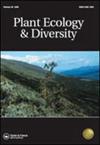桦树种的白色树皮作为剥树皮哺乳动物的警告信号
IF 1.6
4区 生物学
Q2 PLANT SCIENCES
引用次数: 2
摘要
桦树物种,如白桦有明显的白色树皮和进化驱动这种颜色仍未解决。目的我们评估了我们的假设,即白色树皮是一种视觉警告信号,以阻止哺乳动物剥树皮。许多种类的鹿(鹿科)和许多其他哺乳动物食用树皮。白桦树的树皮含有白桦素和其他化合物,这些化合物可能使树皮对食草动物无利可图。白色树皮的特征与食草哺乳动物的视觉信号一致,可以作为化学防御的视觉警告信号。方法对苏格兰林地不同树种鹿皮剥落情况进行比较。以白桦为研究对象,对幼树皮褐剥和成熟树皮白剥进行了比较。我们还回顾了现有的文献,以发现广泛的树皮剥剥哺乳动物的树种偏好。结果在苏格兰,我们发现白树皮桦树皮不太受欢迎。我们还发现,与幼树皮相比,成熟的白桦树皮被避免使用。现有文献表明,白桦树的树皮通常不被偏爱或被避免。结论白桦树皮明显的白色可能是一种视觉警示信号,可以威慑剥树皮的哺乳动物。本文章由计算机程序翻译,如有差异,请以英文原文为准。
White bark in birch species as a warning signal for bark-stripping mammals
ABSTRACT Background Birch species such as Betula pendula have conspicuous white bark and the evolutionary drivers for this colouration remain unresolved. Aims We evaluated our hypothesis that the white bark is a visual warning signal to deter mammals from bark-stripping. Many species of deer (Cervidae) and multiple other mammals consume bark. White birch species’ bark contains betulin and other compounds that likely make the bark unprofitable for herbivores. The white bark has features consistent with a visual signal for mammalian herbivores and could act as a visual aposematic signal of chemical defence. Methods We compared deer bark-stripping between tree species in Scottish woodlands. For Betula pendula, we compared stripping of juvenile brown bark with mature white bark. We also reviewed existing literature to find the tree-species preference for a wide-range of bark-stripping mammals. Results In Scotland, we found that white-barked birch bark was less preferred. We also found mature white birch bark was avoided compared to juvenile brown bark. Existing literature for multiple herbivores showed that white birch species’ bark was often either not preferred or avoided. Conclusion We suggest that the conspicuous white colouration of birch bark may act as an aposematic visual signal to deter bark-stripping mammals.
求助全文
通过发布文献求助,成功后即可免费获取论文全文。
去求助
来源期刊

Plant Ecology & Diversity
PLANT SCIENCES-
CiteScore
3.30
自引率
0.00%
发文量
26
审稿时长
3 months
期刊介绍:
Plant Ecology and Diversity is an international journal for communicating results and novel ideas in plant science, in print and on-line, six times a year. All areas of plant biology relating to ecology, evolution and diversity are of interest, including those which explicitly deal with today''s highly topical themes, such as biodiversity, conservation and global change. We consider submissions that address fundamental questions which are pertinent to contemporary plant science. Articles concerning extreme environments world-wide are particularly welcome.
Plant Ecology and Diversity considers for publication original research articles, short communications, reviews, and scientific correspondence that explore thought-provoking ideas.
To aid redressing ‘publication bias’ the journal is unique in reporting, in the form of short communications, ‘negative results’ and ‘repeat experiments’ that test ecological theories experimentally, in theoretically flawless and methodologically sound papers. Research reviews and method papers, are also encouraged.
Plant Ecology & Diversity publishes high-quality and topical research that demonstrates solid scholarship. As such, the journal does not publish purely descriptive papers. Submissions are required to focus on research topics that are broad in their scope and thus provide new insights and contribute to theory. The original research should address clear hypotheses that test theory or questions and offer new insights on topics of interest to an international readership.
 求助内容:
求助内容: 应助结果提醒方式:
应助结果提醒方式:


